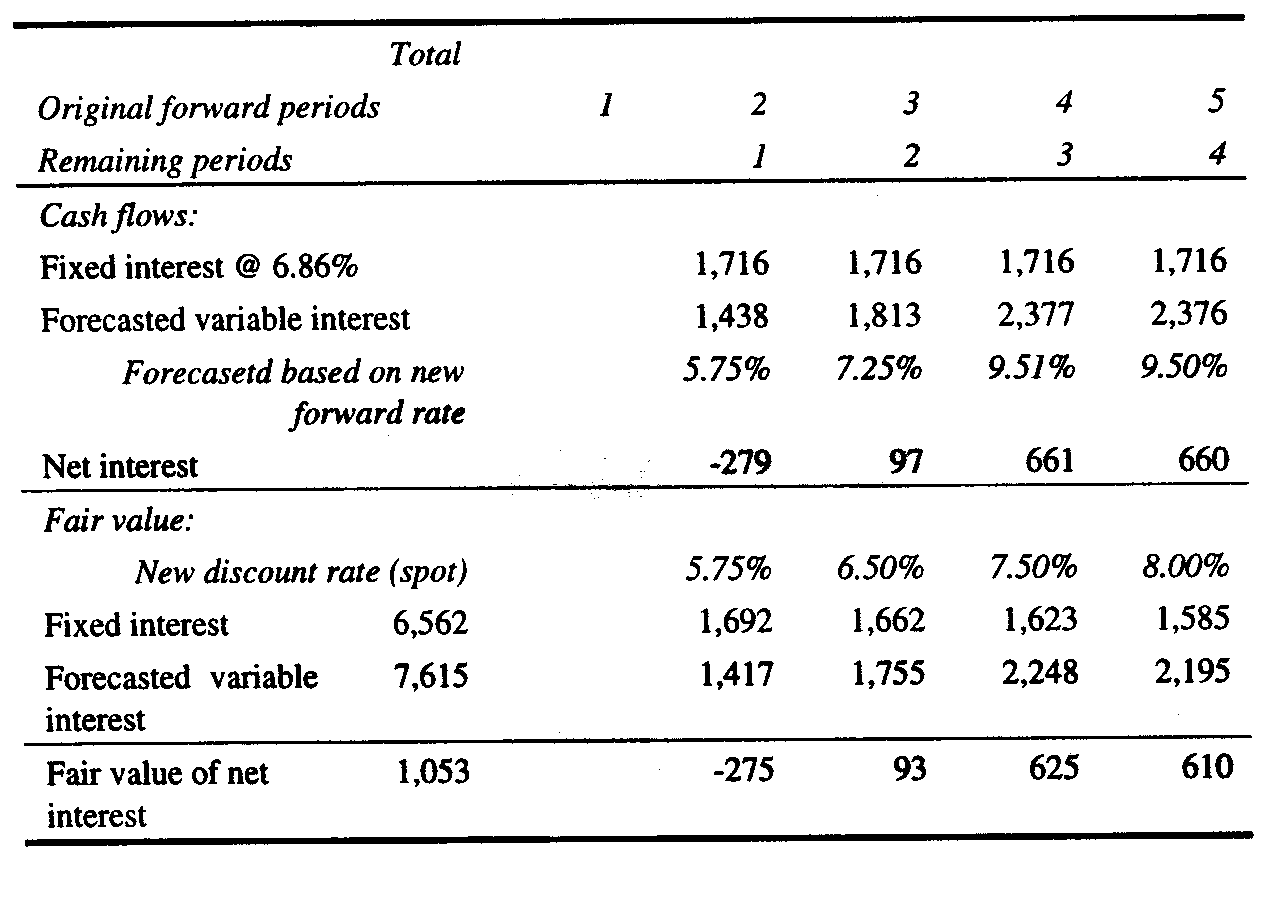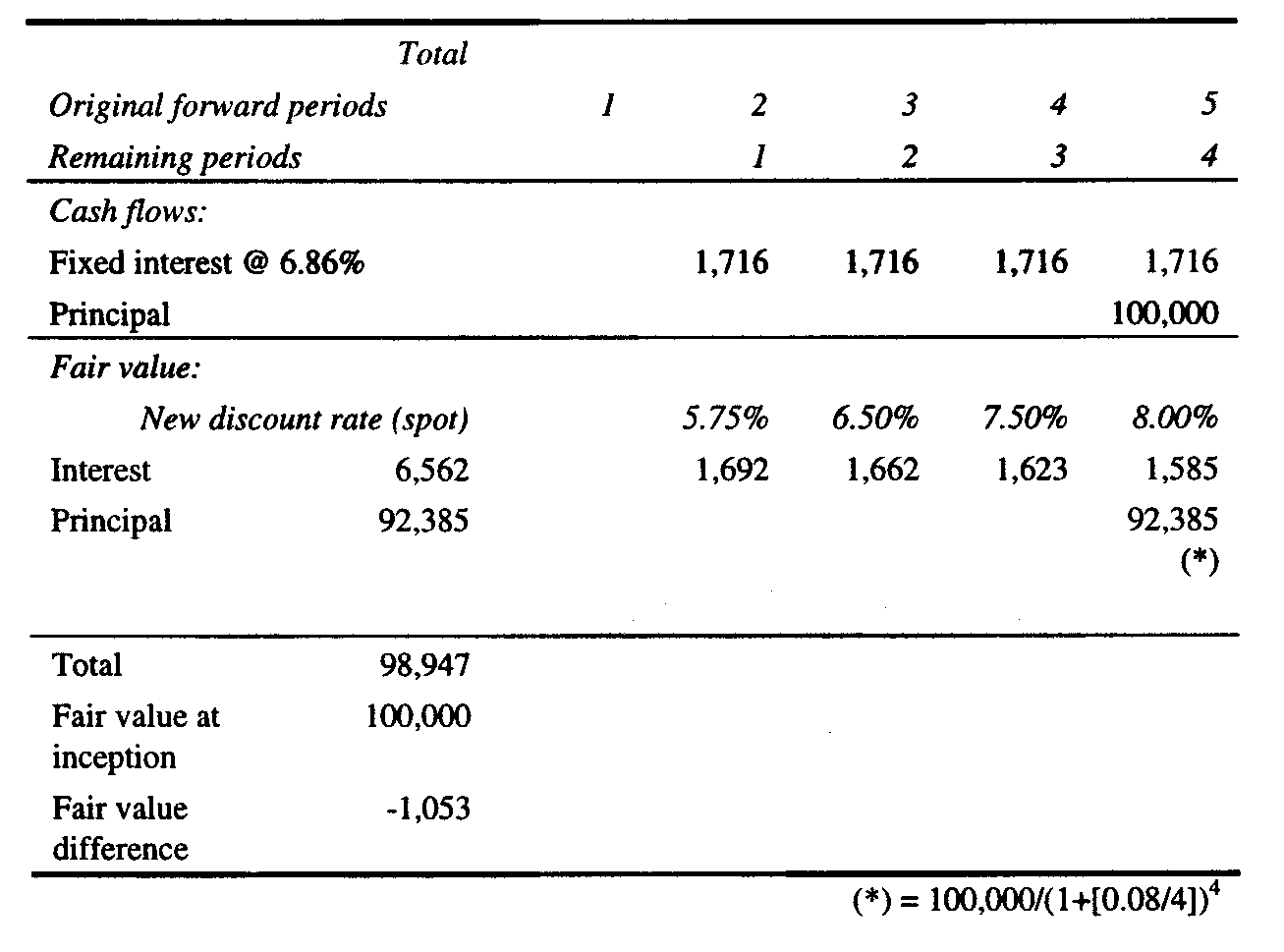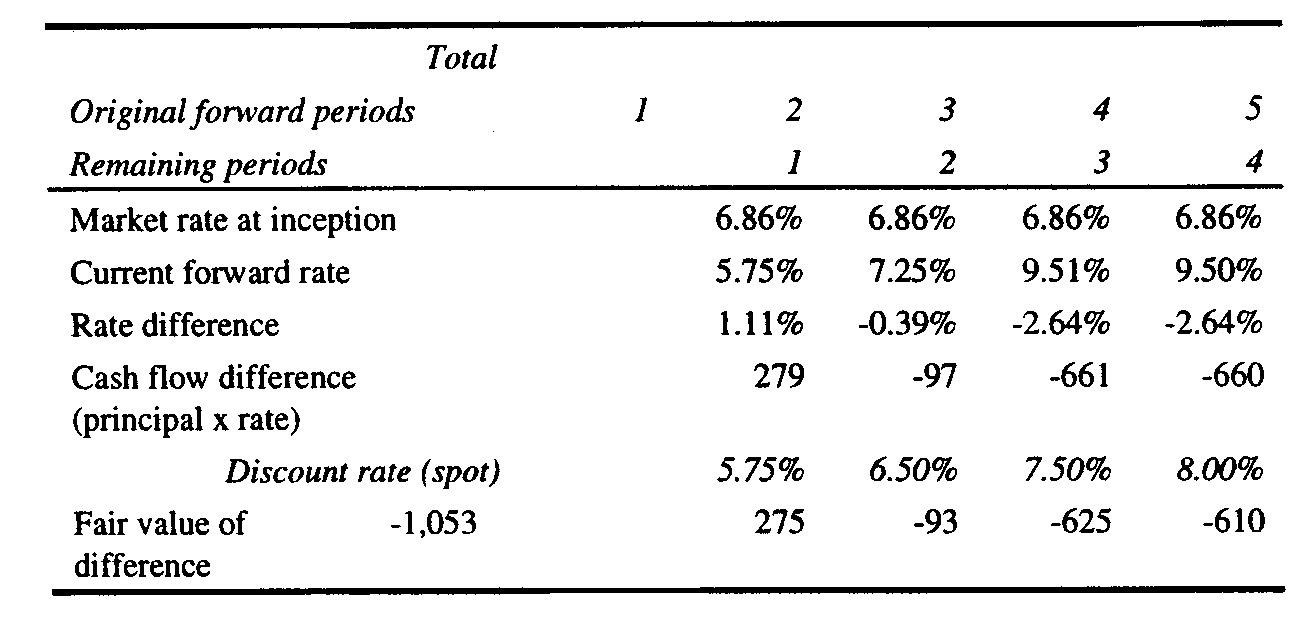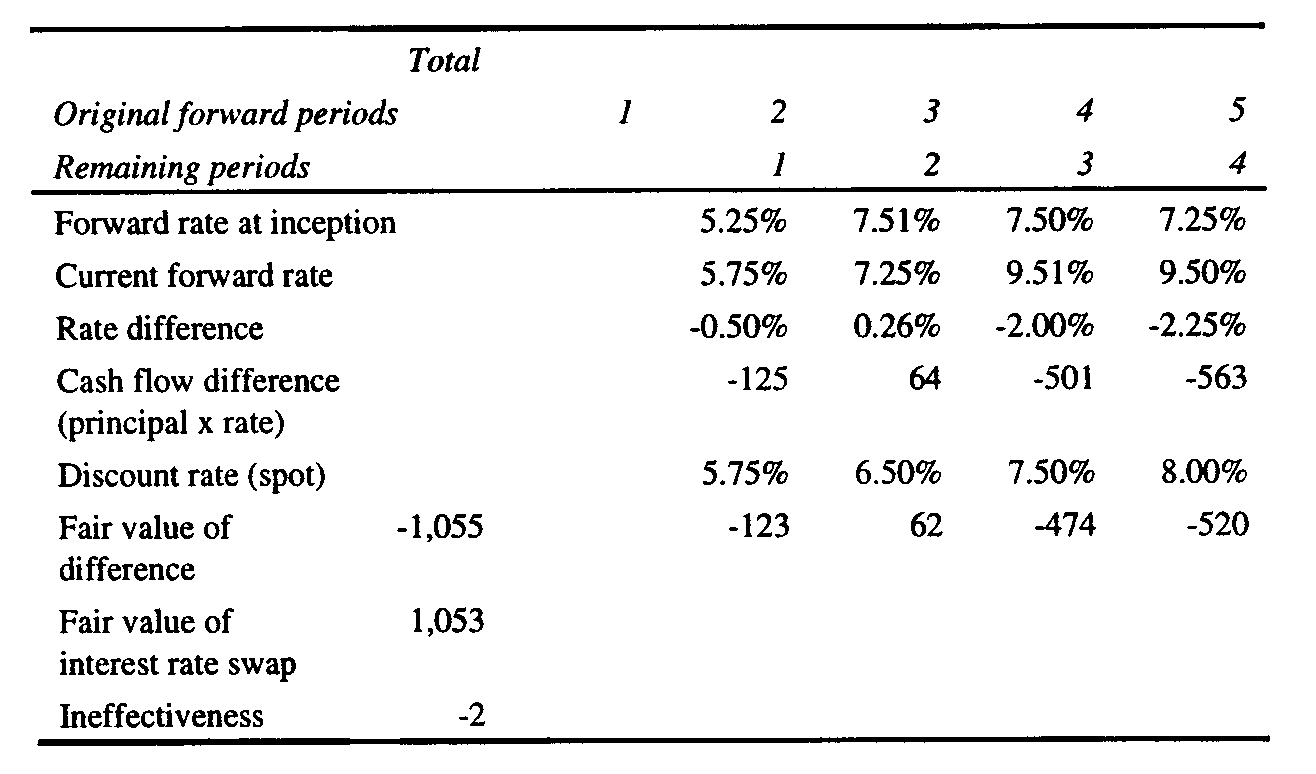|
Working Paper 305 This
paper was published in ”An Explanation of Example 5, Cash Flow Hedge
of Variable-Rate Interest Bearing Asset in SFAS 133,”
by Carl M. Hubbard and Robert E. Jensen, Derivatives Report, April
2000, pp. 8-13. Some
Corrections and Explanations of Example 5 in FAS 133 (March 10, 2000 Version) Carl M. Hubbard and Robert E. Jensen Trinity University San Antonio, Texas Correcting
the Errors and Explaining the Table
Summary,
Conclusions, and Acknowledgements In 1998, the Financial Accounting Standards Board (FASB) issued the derivatives and hedge accounting FAS 133 (or FAS 133) standard that will be one of the most costly and confusing of all FASB standards to implement.[i] This paper is the second of two papers that are intended to help readers cope with the two most difficult illustrations in FAS 133. The first paper on Example 2, which dealt with a fair value interest rate swap, was published in Derivatives Report, November 1999, pp. 6-11. With regard to Example 5 on pages 72 – 76 of FAS 133, which is supposed to demonstrate the mechanics of accounting for a cash flow interest rate swap, we contend that information necessary for understanding Example 5 was omitted and that the table on page 75 of FAS 133 contains a repeating error that that confounds attempts to understand the development of the example. In this paper we discuss and explain the table on page 75 of FAS 133 and correct the Interest accrued errors. We also supply yield curves that are consistent with swap values in the table on page 75 and demonstrate the calculation of expected swap cash flows from forward rates that are derived from the yield curves. The data omitted from Example 5 are the yield curves that were used to calculate forward rates that in turn are used to calculate expected swap cash flows. The swap values at the reset dates in the table on page 75 are the present values of future expected swap cash flows that are discounted at rates in the unknown yield curves. This is unfortunate omission in FAS 133. The flat yield curve assumption for Example 2 allows readers to follow the example without information beyond that provided in our earlier paper, but the upward sloping yield curve assumption in Example 5 requires disclosure of the yield curve at each reset date in order to verify the swap values and understand the example. Our discussion of Example 5 begins with Paragraph 133 on page 73 of FAS 133. A companion paper will focus on Example 5 beginning in Paragraph 131. Introduction to Example 5 in FAS 133 Example 5 focuses on an application of FAS 133 by XYZ Company that has entered into an effective, receive fixed/pay variable interest rate swap that extends over eight quarters. In the swap contract XYZ receives a fixed (6.65%) rate and pays a variable LIBOR rate on a notional principal amount of $10 million. This swap hedges the company’s expected cash flows from $10 million of notional principal that earns a floating annual rate of LIBOR + 2.25%. All payments and reset dates are quarterly beginning July 1, 20X1. Since XYX has entered into a receive fixed/pay variable swap, XYZ obviously is concerned that LIBOR rates would decline and thus reduce the income from the floating rate investment. Exhibit 1 below summarizes the facts assumed in the interest rate swap in Example 5.
Exhibit 1: Terms of the Interest Rate Swap and Corporate Bonds in Example 5
Interest Rate Swap
Corporate
Bonds Trade date and borrowing date July 1, 20X1 July 1, 20X1 Termination date June 30, 20X3 June 30, 20X3 Notional amount $10,000,000 $10,000,000 Fixed interest rate 6.65% Not applicable Variable interest rate 3-month US$ LIBOR 3-month US$ LIBOR + 2.25% Settlement dates and interest End of each calendar End of each calendar payment dates quarter quarter Reset dates End of each calendar End of each calendar quarter through quarter through March 31, 20X3 March 31, 20X3
The above Example 5 has been modified somewhat by the March 3, 2000 FASB Exposure Draft No. 207-A containing several proposed amendments to FAS 133. However, the numerical outcomes and the Page 75 answers were not revised from the original Example 5 in FAS 133. We still see the need for proposing some corrections and explanations of the Page 75 results. Correcting
the Errors and Explaining the Table The Interest Accrued amounts on Page 75 of FAS 133 are not compatible with the swap value and LIBOR rates at the reset dates. Either the Interest accrued amounts or the swap values are incorrect. For the reader’s convenience, the original table from page 75 of FAS 133 is reproduced in Exhibit 2 below. Our corrected version of the table is presented in Exhibit 3. Readers may download an Excel workbook, best read in Excel, with cell comments that compare the FASB's original Page 75 of FAS 133 with our corrected table from http://www.trinity/edu/rjensen/caseans/133ex05d.htm. Insert Exhibits 2 and 3 Accepting the swap values as correct does less damage to the table, thus we assume the Interest accrued amounts must be corrected. Our Exhibit 3 reports the corrected Interest accrued amounts for each quarter using the LIBOR rates listed on page 74 of FAS 133. Since the initial present value of expected swap cash flows must be zero, the Interest accrued as of 9/30/X1 is correctly given as zero in the table on page 75 of FAS 133, in Exhibit 2, and Exhibit 3. By 9/30/X1 the LIBOR has changed, and the present value of expected swap cash flows beyond 9/30/X1 is revised to $24,850. The Interest accrued on $24,850 on 12/31/X1 is $350 or 0.0563/4 x $24,850. Thus in Exhibit 3 the Interest accrued amount for 12/31/X1 is corrected to show the $350 amount. Since the swap values are assumed to be correct in the original table, Effect of change in rates is adjusted also by the correction. Again on 12/31/X1 the present value of expected swap cash flows is recalculated using an unspecified yield curve and is $73,800. The Interest accrued on $73,800 on 3/31/X2 is 0.0556/4 x $73,800 or $1,026, not $1,210 as presented in the original table. As before, the entry for Effect of change in rates is also adjusted. Because of changes in interest rates and because of the passage of time, the present values of expected swap cash flows change each quarter. Each quarter’s Interest accrued in Exhibit 3 is recalculated using the reset LIBOR at the beginning of the quarter, and as seen in Exhibit 3 each quarter’s entry for Effect of change in rates is also corrected.[ii] The actual swap payments (receipts) as of the reset dates for the eight quarters are shown in Paragraph 138, page 76 of FAS 133. The payment (receipt) is equal to the variable LIBOR rate paid in the swap less the fixed rate received times the notional principle, or on 9/30/X1 (0.0556 – 0.0665)/4 x $10 million = ($27,250), a receipt. On 12/31/X1 the swap payment (receipt) is (0.0563 – 0.0665)/4 x $10 million = ($25,500). The swap cash flows are calculated in that same manner for each quarter throughout the life of the swap. Each quarter’s Effect of change in rates is equal to the current period’s recalculated value of the swap less the previous period’s swap value less the current period’s Interest accrued less the current period’s swap payment (receipt). In other words Effect of change in interest rates is the balancing item. As shown in Exhibit 3, the effective swap terminates on 6/30/X3 with a zero value, and the 3/31/X3 present value of the one remaining swap cash flow is amortized by the swap payment (receipt) on 6/30/X3, the Interest accrued on the 3/31X3 value of the swap, and an accumulated rounding error, if any. We believer, therefore, that our Exhibit 3 is the correct presentation of entries related to Example 5. Discovering
the Yield Curves The underlying swap yield curves are unfortunately not disclosed by the FASB in Example 5. The swap values at the reset dates are the present values of the future expected swap cash flows. The cash flows that are discounted to the present value at each reset date cannot be known without the yield curves and the forward rates that are used to calculate the future quarterly expected cash flows. Furthermore, the discount rates that are used to calculate the values of the swap at the reset dates are the zero-coupon LIBOR’s that comprise the yield curves on the reset dates. Thus, in this example where an upward sloping yield curve is assumed, we must be given the yield curves at each reset date in order to replicate the calculations in the example. If we cannot easily replicate the example, it ceases to be an example in a pedagogical sense. Nevertheless, we have discovered how the swap values on Page 75 of FAS 133 may have derived. In order to see how we derive yield curves that provide the same swap values given in the table on page 75 of FAS 133, the reader may wish to download the Excel workbook in Excel at http://http://faculty.trinity.edu/rjensen/caseans/133ex05a.xls and study the spreadsheet called "Effective." For this paper, we derived a yield curve at each reset date that provides the FASB’s swap values in the table on page 75 of FAS 133. We have some concerns as to whether the FASB’s swap values are theoretically sound, but that issue is reserved for another paper. A yield curve is the graphic or numeric presentation of bond equivalent yields to maturity on debt that is identical in every aspect except time to maturity. In developing a yield curve, default risk and liquidity, for example, are the same for every security whose yield is included in the yield curve. Thus yields on U. S. Treasury issues are normally used to plot Treasury yield curves. The relationship between yields and time to maturity is often referred to as the term structure of interest rates. Similarly, an unknown set of estimated LIBOR yield curves underlie the FASB swap valuations calculated in Exhibit 3. Other than providing the assumption that the yields in the yield curves are zero-coupon rates, the FASB offers no information that would allow us to derive the yield curves or calculate the swap values in Example 5. The typical yield curve gradually increases relative to years to maturity. That is, historically, short-term rates are somewhat lower than longer-term rates. In a recession with deflation or disinflation the entire yield curve shifts downward as interest rates generally fall and rotates counter-clockwise indicating that short-term rates have fallen to much lower levels than long-term rates. In rapid economic expansion accompanied by inflation, interest rates tend to rise and yield curves shift upward and rotate clockwise indicating that short-term rates have increased more than long-term rates. [iii] The different shapes of the yield curve described above complicate the calculation of the present value of an interest rate swap and require the calculation and application of implied forward rates to calculate future expected swap cash flows. Fortunately Example 2 assumes that a flat yield curve prevails at all levels of interest rates. A flat yield curve means that as interest rates rise and fall, short-term and long-term rates move together in lock step, and future cash flows are all discounted at the same current discount rate. The cash flows and values in Example 5, however, are developed from the prevailing upward sloping yield curve at each reset date. After reviewing the cases in Teets and Uhl, we used the tool Goal Seek in Excel to derive upward sloping yield curves and swap values at the reset dates that equal the FASB's values in the table on Page 75 of FAS 133.[iv] Exhibit 5 below shows the results of our calculations of the expected swap cash flows at each reset date and the value of the swap in Example 5 at each reset date. In order to see how we believe the swap values in the original table were derived for Example 5, the reader may wish to download the Excel workbook using Excel at http://http://faculty.trinity.edu/rjensen/caseans/133ex05a.xls and select “Effective.” Insert Exhibit 4 here In the development of Exhibit 4 we began with the derivation of a yield curve of LIBOR rates that provide a zero present value of future expected swap cash flows at the initiation of the swap. The only rate given in Example 5 for that first yield curve is 5.56% for the first quarter. Since the yield curve is upward sloping, we calculated a trial yield curve that begins at 5.56% and increases x% each quarter in the future. By supplying a value for x, we derived the trial yield curve and then calculated forward rates from that yield curve. The forward rates in this example are the future expected spot LIBOR rates that are implied by the zero-coupon rates in a yield curve. For example, assume that we have a two-year investment horizon and that the one-year LIBOR is 6.0% and the two-year LIBOR is 6.5%. If the LIBOR market is in equilibrium with respect to current rates and future expected rates, the 6.5% two-year rate must be the geometric mean of the one-year rate of 6.0% and the expected one-year rate beginning one year from now, which is 7.0%. A forward rate is calculated in the following manner: f(t) = [1 + r(t)]t/[1 + r(t-1)]t-1 – 1 (1) in which f(t) is the forward rate for time period t, r(t) is the multi-period yield that spans t periods, and r(t-1) is the yield for an investment of t-1 periods. In the example above, 6.5% is r(t) and 6.0% is r(t-1). Thus, f(2), the forward LIBOR for year 2, is calculated as follows f(2) = (1.065)2/1.06 – 1 = 0.07 or 7.0% (2) Having calculated a forward rate for each quarter from the rates in the trial yield curve, we then asked Excel to give us the value of x, the slope of the upward sloping yield curve, that would provide a yield curve with forward rates that would calculate future expected swap cash flows whose present value is zero. The resulting yield curve, quarterly equivalent rates, forward rates, expected swap cash flows, and present values of cash flows as of 7/1/X1 are shown in the Panel 1 of Exhibit 4. A seen in Panel 1 of Exhibit 4, the first derived yield curve starts at 5.56% for the period ending 9/30/X1 and ends with a LIBOR of 6.68% for Eurodollar deposits maturing on 6/30/X3. Future expected swap cash flows in Exhibit 4 are equal to the fixed rate received in the swap (0.0665/4) less the calculated forward rate times the notional principal. On 7/1/X1 in Example 5, the first quarter’s LIBOR of 5.56%/4 or 1.390% is also the first quarter’s forward rate, and the first period’s swap cash flow is (0.0665/4 - 0.0139) x $10 million = $27,250. The second quarterly forward rate is 1.470%, and the second quarter’s expected swap cash flow is (0.0665/4 - 0.0147) x $10 million = $19,265. The third quarterly forward rate is 1.550%, and so forth. When the thus calculated, the expected swap cash flows are discounted to the present value using the yields in the yield curve as discount rates. On 7/1/X1 the present value of the first swap cash flow of $27,250 is $27,250/1.0139 or $26,876. The present value of the second swap cash flow of $19,265 is $19,265/(1.01432) or $18,725, and so forth through the remaining six quarters. As shown in Exhibit 4, the 7/1/X1 the initial sum of the present values of the eight expected swap cash flows is zero. At the first reset date of 9/30/X1 in Example 5 the spot LIBOR increases to 5.63%. We derived the LIBOR yield curve for 9/30/X1 using Goal Seek in the same manner as described above. We asked Excel to calculate a value of x, the slope of the new yield curve beginning at 5.63%, that would give us a yield curve whose forward rates would provide swap cash flow calculations whose present value discounted at the yields in the yield curve equals $24,850. The results of those calculations are presented in the Panel 2 of Exhibit 4. We repeated that yield curve, forward rate, cash flow, and present value derivation process in Excel for each of the remaining reset dates in Example 5. The results of those derivations are given in Panels 3 through 8 of Exhibit 4. Since the interest rate swap is assumed to be effective, the concluding swap value on 6/30/X3 is zero. Summary
and Conclusions
Example 5 of FAS 133 is supposed to provide an example of accounting entries for a receive fixed/pay variable interest rate swap that that effectively hedges the variable interest income from an investment. However, the table on page 75 of FAS 133 is incorrect, and the information provided in Example 5 on the derivation of swap values is incomplete. The page 75 table reports Interest accrued amounts that are inconsistent with the given LIBOR rates and swap values. The LIBOR rates in the upward sloping yield curves that were used to derive forward rates, future expected swap cash flows, and swap values at the reset dates are not given in the example. Our objective in this paper was to correct the errors in the page 75 table, explain the entries in the corrected table, and then provide yield curves that are consistent with the swap values given in Example 5. We explain the derivation of trial yield curves, forward rates, swap cash flows, and swap values in Example 5. The corrected table in Exhibit 3 combined with the yield curve data and forward rates in Exhibit 4 enable a reader to understand the derivation of the cash flows, swap values, and other accounting entries that are the subjects of Example 5. Readers may download an Excel workbook demonstrating our calculations from http://http://faculty.trinity.edu/rjensen/caseans/133ex05a.xls Acknowledgments We want to acknowledge the help from two individuals who independently found a calculation error in our first round of calculations. Thanks go to Peter van Amson from BankWare Inc and Dr. Walter R. Teets from Gonzaga University. Dr. Teets and his co-author, Robert Uhl, provide a free book online at at http://www.gonzaga.edu/faculty/teets/index0.html. Peter van Amson sent us a corrected version of our own spreadsheet. He also recommended the following references: For W.R.T. swaps the standard text used in practice is the Hull Book. Options, Futures and Other Derivatives, John C. Hull it has a fairly straight forward valuation of swaps. For an "advanced" actually just more mathematical treatment of the problem I recommend Interest Rate Option Models, Ricardo Rebonato. The Hull reference is as follows: John C. Hull, Options, Futures, and Other Derivatives (Prentice-Hall, 1999, ISBN: 0130224448) The Rebonato referernce is as follows: Ricardo Rebonato, Interest Rate Option Models (John Wiley & Sons, Wiley Finance, 1998, ISBN 0-471-96569-3)
Footnotes
[i] The reader may learn more about FAS 133 and other FASB standards at http://www.rutgers.edu/Accounting/raw/fasb/st/stpg.html. Also note the March 3, 2000 FASB Exposure Draft No. 207-A containing several proposed amendments to FAS 133 at http://www.rutgers.edu/Accounting/raw/fasb/draft/amend133_ED.pdf. [ii]
Accrued interest on the present value of future expected cash flow
from the swap as of the end of the previous period for the eight
quarters is calculated as follows: 9/30/X1:
($Swap value)(LIBOR/4) = ($0)(0.0556/4) = $0 12/31/X1:
($24,850)(0.0563/4) = $350 3/31/X2:
($73,800)(0.0556/4) = $1,026 6/30/X2:
($85,910)(0.0547/4) = $1,175 9/30/X2:
(-$42,820)(0.0675/4) = ($723) 12/31/X2:
(-$33,160)(0.0686/4) = ($569) 3/31/X3:
(-$21,850)(0.0697/4) = ($381) 6/30/X3:
($1,960)(0.0657/4) = $32 [iii] See Chapter 6 “The Term Structure of Interest Rates” in James C. Van Horne Financial Market Rates and Flows, 5th Edition. Upper Saddle River, NJ: 1998 for an excellent discussion of yield curves. [iv] See “J. Adams and Company: Accounting for Interest Rate Swaps in an Upward Sloping Yield Curve Environment” in Introductory Cases on Accounting for Derivative Instruments and Hedging Activities, 1998, by Walter R. Teets and Robert Uhl. This case and other cases are available free online at http://www.gonzaga.edu/faculty/teets/index0.html.
|
|||||||||||||||||||||||||||||||||||||||||||||||||||||||||||||||||||||||||||||||||||||||||||||||||||||||||||||||||||||||||||||||||||||||||||||||||||||||||||||||||||||||||||||||||||||||||||||||||||||||||||||||||||||||||||||||||||||||||||||||||||||||||||||||||||||||||||||||||||||||||||||||||||||||||||||||||||||||||||||||||||||||||||||||||||||||||||||||||||||||||||||||||||||||||||||||||||||||||||||||||||||||||||||||||||||||||||||||||||||||||||||||||||||||||||||||||||||||||||||||||||||||||||||||||||||||||||||||||||||||||||||||||||||||||||||||||||||||||||||||||||||||||||||||||||||||||||||||||||||||||||||||||||||||||||||||||||||||||||||||||||||||||||||||||||||||||||||||||||||||||||||||||||||||||||||||||||||||||||||||||||||||||||||||||||||||||||||||||||||||||||||||||||||||||||||||||||||||||||||||||||||||||||||||||||||||||||||||||||||||||||||||||||||||||||||||||||||||||||||||||||||||||||||||||||||||||||||||||||||||||||||||||||||||||||||||||||||||||||||||||||||||||||||||||||||||||||||||||||||||






